Why Truck Owners Should Care About Fuel Cells
Jason Lancaster | Jul 29, 2015 | Comments 2
Toyota’s new Mirai isn’t terribly impressive at first glance. It’s pricey (about $70k), it will be difficult to refuel outside of Los Angeles or San Francisco, and it’s not very fast (a zero to 60 time of about 10 seconds).
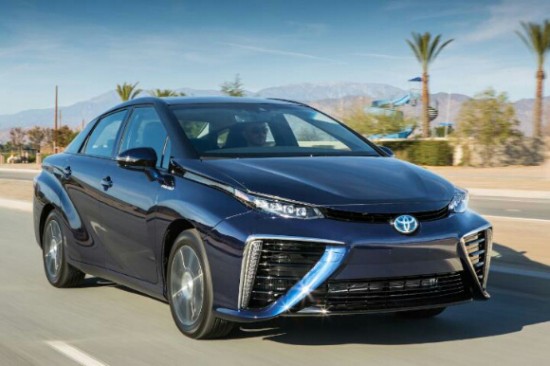
Toyota’s new Mirai might not look like big news to pickup fans, but hydrogen fuel cells are likely to be a big part of Toyota’s plan for the Tundra.
However, the technology underneath is the game changer…especially for trucks. Hydrogen is almost certain to become the predominant alternative fuel for trucks and large SUVs. Here’s why.
Why Are Automakers Pursuing Hydrogen Fuel Cell Vehicles?
If you’ve been paying attention to the conversation around fuel cells, you’ve like heard some of the benefits they offer over battery powered vehicles:
- Hydrogen fuel cell vehicles (FCVs) can be refueled quickly – 3-5 minutes to fill a tank that should offer hundreds of miles of driving range.
- Hydrogen can be created using nothing more than electricity and water, which (assuming the electricity is generated from wind or solar power) makes a hydrogen FCV 100% renewable.
- Hydrogen FCVs don’t have a range problem, at least if you’re able to find a hydrogen fueling station (which is a rarity at this point, but could change in the near future).
While the “boo birds” love to point out all the problems with hydrogen FCVs (which we’ll get to in a moment), truck owners should be particularly interested in fuel cells for one more reason: fuel cells are lightweight, at least when compared to battery packs.
Battery Packs Don’t Really Work For Large Vehicle Applications
Electric vehicle battery packs aren’t a good fit for trucks and large SUVs. Here’s why:
- The energy density of a Tesla battery pack (which are the most advanced available) is 250 watt-hours per kilogram, which means that one of the bigger packs Tesla offers (85kWh) weighs about 750lbs.
- When used in a 4,700lbs Tesla Model S with an incredible 0.24 drag coefficient, an 85kWh battery pack is able to achieve 265 miles of range (EPA rating).
Now imagine taking that same battery pack and dropping it into a half-ton pickup truck. The weight would be near 5,000lbs, probably higher. Next, a half-ton truck’s drag coefficient is 50% higher than a Model S, and it has a much larger frontal area too. Doing some math, the higher frontal area of a typical truck plus the higher drag coefficient effectively doubles aerodynamic drag. Combine that dramatic increase in drag with additional weight, and you end up with a truck that might struggle to go 120 miles…and that’s before we hook up a trailer or load up the bed.
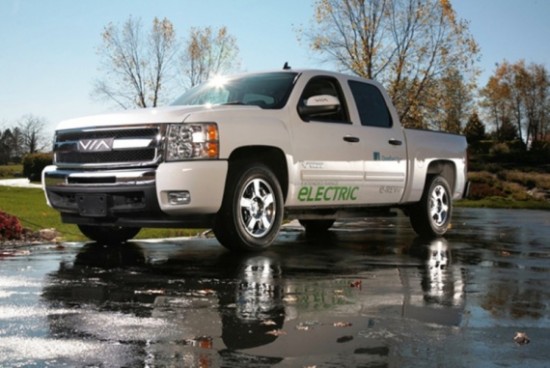
When you consider the aerodynamics and the diminishing returns associated with heavy battery packs, it’s easy to understand why Via Motors (a company that already offers electric pickup trucks) can only get a truck to go about 40 miles on a battery pack.
Summing up, battery packs are heavy and trucks aren’t aerodynamic. If you wanted to get 300 miles of driving range out of an electric pickup truck, you’d probably need a 200kWh battery pack that would weigh an astounding 1,800 lbs. If you wanted to tow/haul and have any sort of acceptable driving range, you’d need even more battery capacity.
All those kWh of battery capacity add up to thousands of pounds of weight. Which is why battery packs are a bad fit for trucks.
But Toyota (and Other Automakers) NEED Zero Emissions Trucks
As we’ve written more than once here on TundraHeadquarters, federal fuel economy rules are getting stricter and stricter. All automakers are heavily incentivized to find ways to build zero-emissions vehicles, as these vehicles dramatically impact the fleet fuel economy rating.
Battery-electric vehicles – as well as hydrogen fuel cell vehicles – are considered “zero emissions” as far as regulators are concerned, and every zero emissions vehicle is like a “bonus” in terms of calculating fleet fuel economy ratings. And larger vehicles that just so happen to be zero emissions? That’s like a triple bonus. Every zero emissions Tundra, for example, is probably worth 3 Mirais when it comes to calculating the fleet average.
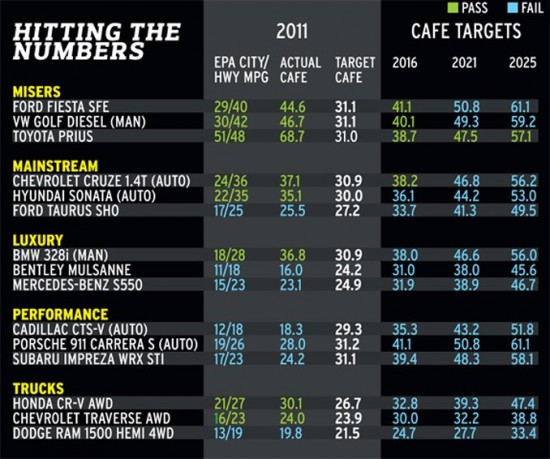
CarandDriver.com created a nice summary of the targets different types of vehicles need to hit. A zero-emissions truck has a much larger impact on the fleet average than a zero emissions car, as cars are expected to be very efficient anyways.
Basically, automakers need to find a way to build as many zero emissions vehicles as they can, and building larger zero emissions vehicles is a very good idea.
Enter Hydrogen Fuel Cells
Battery packs won’t work for pickup trucks, at least not unless someone figures out how to double or triple the energy density. Which brings us to hydrogen fuel cells:
- The fuel cell stack needed to move a truck will weigh about the same as a comparable V6 or V8, and should fit into an existing engine compartment.
- The weight of all the other “parts” (electric drive motors, regenerative brakes, composite hydrogen fuel tanks), etc., should be manageable…a few hundred pounds.
- Toyota says they can make the price point of hydrogen fuel stacks comparable to existing gasoline hybrids, which means that they’ll only be 10-15% more than a gas powered truck of similar size and capability.
While it’s hard to imagine a fuel cell powered Tundra offering the acceleration or tow capacity of a gas powered Tundra (fuel cells offer anemic power levels, at least currently), it’s easy to imagine fleets and govt. buyers investing in fuel cell powered Tundra to bolster their “green” credentials.
It’s also easy to imagine automakers incentivizing fuel cell truck sales to boost their federal fuel economy standards (and thus avoiding hefty fines for noncompliance).
But Aren’t Fuel Cells Dangerous? Or Bad For The Earth? Or Wildly Expensive?
Haters gotta hate, right? When you tell a Tesla fan that hydrogen is the most logical zero emissions fuel for pickup trucks, they often get an angry look and explain that:
- Hydrogen is dangerous cause’ it is explosive – remember the Hindenburg!
- Hydrogen can’t be transported/distributed easily
- Hydrogen fuel cell stacks are really expensive
- Hydrogen isn’t really green unless it’s produced via electrolysis, and no one is really doing that
On the first point, hydrogen doesn’t explode nearly as easily as gasoline – the DOE tested a fuel fire on a hydrogen powered vehicle and compared it to a vehicle with an old-fashioned gas tank. Here’s a picture of that test after 1 minute (the gas powered car is on the right):
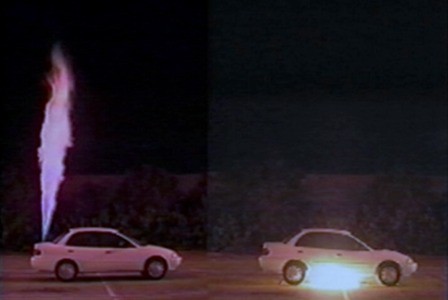
Hydrogen rises and burns “up.” Gasoline pools.
Gasoline is much more dangerous than hydrogen because it pools beneath the car. Hydrogen floats away so fast that flames can barely keep up.
On the second point, hydrogen can’t be transported very easily…but that’s OK because it’s produced locally in an awful lot of markets. Here’s a map of hydrogen production in the USA, with blue triangles for each facility:
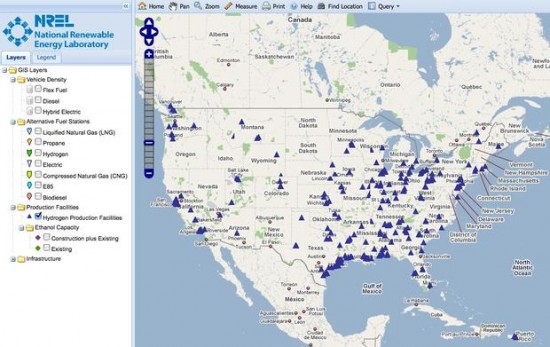
Hydrogen production facilities in the USA
It’s not everywhere, but it’s available in most major markets. Transport isn’t a deal breaker (nor is production, it seems). If there’s a local plant, the local hydrogen filling stations will be able to get the hydrogen their customers need.
On the third point, fuel cell stacks are expensive…today. But they were far, far more expensive five years ago, and Toyota has committed to reducing the price substantially between 2020 and 2025. Toyota’s stated goal is to produce a fuel cell stack for the same price as a standard gasoline hybrid powertrain (about 15% more costly than a standard gas engine). Can they do it? Who knows. But Toyota sure does have an awesome engineering track record, don’t they?
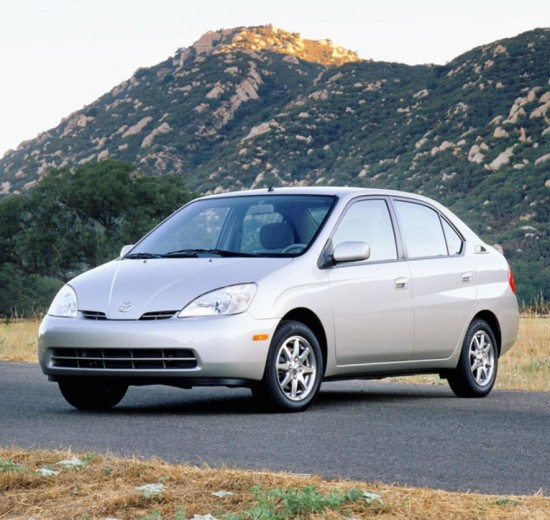
The critics said that Toyota couldn’t ever build a gasoline hybrid for an affordable price. Guess how that worked out?
On the fourth and final point, the critics are right. Today, using current technology, electrolysis really isn’t used to produce hydrogen. Most of it comes from steam reformation of domestic natural gas. It’s not as “green” as say, electricity from a wind generator or solar cell stored in a battery pack.
But it’s also not as “dirty” as gasoline, and when it comes to pickup trucks, gas (or diesel) are the only viable fuel options. As explained above, battery packs are heavy and trucks aren’t very aerodynamic…battery technology needs to improve dramatically for battery-powered pickups to become a reality.
Between now and then, hydrogen powered trucks is a good compromise.
Will We See a Hydrogen Powered Toyota Tundra?
I’d like to think so, but that assumes that consumers embrace hydrogen in the short term, and that Toyota figures out how to drop fuel cell stack costs. But assuming that these changes come to pass, a hydrogen-powered Tundra seems 100% feasible…especially if it’s offered in limited markets (NY and CA) and sold to buyers who will use them locally (like commercial fleets). We could see them as soon as the next big Tundra redesign (2022 or so).
Obviously, predictions are hard. Especially if they’re about the future. But truck owners would be wise to pay close attention to fuel cell technology, as the odds of a fuel cell stack finding its’ way into a truck are much, much better than the odds of an electric truck that can tow or haul with an acceptable driving range.
Search terms people used to find this page:
- tundraheadquarters
Filed Under: Auto News


As long as it’s not 15%m more expensive, still performs equally well and retains it’s capabilities. I’m all for it.
Jason,
This is a very good and through post on future powertrain technologies. The world and of course transportation is changing rapidly; perhaps more rapidly than anyone expects.
Recently PBS presented a show called Humanity; the view from space – The Black Marble. It is essentially a presentation on were the world population and environment should be in 2050. Just 35 years from now. Our population is growing 200,000 per day. By 2050 the world population is projected to be 9 billion. And apparently; this presents a major crisis for water, food, and fuel.
http://video.pbs.org/search/?q.....from+space
Blending the knowledge you have presented in your post with the PBS 2 hour show should be very enlightening for anyone willing to put in the effort.
Thanks for the post,
Randy